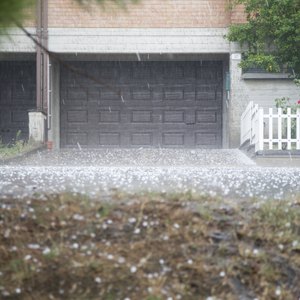
If your home has been damaged by a hail storm, you may be able to claim a casualty loss deduction on your federal income tax return. Usually casualty loss deductions are based on the loss of market value due to the casualty, however, under certain circumstances the deduction can be based on the cost of repairs. This deduction is subject to important limitations, however, including a significant downward adjustment based on income. So, even if you qualify for a tax deduction for repairs of storm damage, you will not be able to deduct the full amount of the repairs. Depending on your income, you may not be able to claim the deduction at all.
Tips
If your home has been damaged during a hail storm, you will be able to claim a deduction based on the current loss of market value due to the storm's effects.
Understanding Casualty Losses
Casualty losses are an itemized deduction claimed on Form 1040, Schedule A, line 20, supported by Form 4684. A casualty is defined by Congress and the Internal Revenue Service as property damage or loss due to a sudden, unexpected, or unusual event. Storms are not excluded from the definition, so a hail storm could cause a casualty loss. Note that losses are deductible in the tax year of the casualty, which may not necessarily be the same tax year in which you make repairs.
Proof of Loss
You will need records supporting your casualty loss claim. These records do not need to be sent to the IRS with your tax return, but should be retained by you to prove your loss in the event your tax return is audited. Your proof of loss records should include the type of casualty – in this case, a hail storm – when it occurred, what losses you suffered as a result of the casualty, and information about any claims you have made for reimbursement, whether from insurance or otherwise. An important component of proving your loss is having documentation that shows either that you own the damaged property or that you are liable for fixing the damage.
Measurement of Loss
Casualty losses are measured by the decrease in fair market value of the property, comparing the fair market value immediately before the event to the fair market value immediately after the event. This loss in value can be determined by an assessment, but it is often simpler to measure the loss in value using repair cost as a proxy. Measuring the loss in value using repair cost is allowed only under specific circumstances. First, the repairs must actually be made. Since casualty losses are deductible in the year of the casualty, rather than the year of the repair, this means that repairs must be made before you file your tax return if you want to use this method.
Second, you can repair only the damage caused by the casualty; the repair cannot increase the property value above what it was before the casualty. For example, if your roof is already badly in need of repair, and the hail storm is just the final nail in its coffin, you cannot replace the roof and use the repair cost method to measure the loss in value. Finally, the amount spent on repairs cannot be excessive.
Deduction is Reduced
Casualty loss deductions are not for the full loss of value. The amount of your deduction is reduced twice on Form 4684 before you enter the deduction on Schedule A. First, you must subtract $100 from your loss. Second, you must subtract 10% of your adjusted gross income from the remaining amount. Depending on your income and the cost of the repairs, your potential casualty loss deduction could be zeroed out.
References
- Internal Revenue Service: Publication 17: Tax Guide
- Internal Revenue Service: Schedule A: Itemized Deductions
- Internal Revenue Service: Publication 547: Casualties, Disasters and Thefts
- Internal Revenue Service: Form 4684: Casualties and Thefts
- Internal Revenue Service. "IRS Provides Tax Inflation Adjustments for Tax Year 2020." Accessed Nov. 6, 2020.
- Internal Revenue Service. "IRS Provides Tax Inflation Adjustments for Tax Year 2021." Accessed Nov. 6, 2020.
- Internal Revenue Service. "2019 Instructions for Form 4684: Casualties and Thefts," Page 1. Accessed Nov. 6, 2020.
- Internal Revenue Service. "2017 Publication 547: Casualties, Disasters, and Thefts," Page 4. Accessed Nov. 6, 2020.
- Internal Revenue Service. "Tax Reform Affects If and How Taxpayers Itemize Their Deductions." Accessed Nov. 6, 2020.
- Internal Revenue Service. "Topic No. 515 Casualty, Disaster, and Theft Losses." Accessed Nov. 6, 2020.
- Congress. "H.R.3823 - Disaster Tax Relief and Airport and Airway Extension Act of 2017." Accessed Nov. 6, 2020.
- Congress. "H.R.1892 - Bipartisan Budget Act of 2018." Accessed Nov. 6, 2020.
- Internal Revenue Service. "Tax Relief in Disaster Situations," Select "Recent Tax Relief: 2020." Accessed Nov. 6, 2020.
Writer Bio
Patricia DeWitt is a CTEC-registered tax professional, a member of the California State Bar and a graduate of Harvard Law School, J.D. class of 2000. Her writing appears on a range of business and finance websites.

